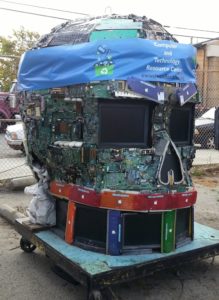Our “Skull-pture” at 620 Page Street
Just Added to Our “Skull-pture” — a headband!
Check out the headband we have added to the skull, which is at our 620 Page Street location in Berkeley. We submit this as a fledgling attempt at “ecological” art. The skull was built by Greenpeace for CTRC years and years ago.
It is also posted to our Facebook page.
From Wikipedia–“Environmental art is an umbrella term for a range of artistic practices encompassing both historical approaches to nature in art and more recent ecological and politically motivated types of works.[1][2]
‘The term “environmental art” often encompasses “ecological” concerns but is not specific to them.[3] It acknowledges the early history of this movement (which was often more about art ideas than environmental ones) as well as art with more activist concerns and art which primarily celebrates an artist’s connection with nature using natural materials.[1][2]
Aviva Rahmani’s Blue Rocks project (2002) drew attention to a degraded estuary on Vinalhaven Island, Maine. The USDA then contributed over $500,000. to restore twenty-six acres of wetlands in 2002. (Photograph by Aviva Rahmani)
The term “environmental art” is used in a variety of different contexts: it can be used to refer to art describing the natural world, art that celebrates personal engagement with the natural world (“art in nature”), and to the practices of ecological artists, whose work directly addresses environmental issues (“ecological art” or “eco-art”)through educating people about the natural world, or intervening in and restoring the natural world. Ecological artist, Aviva Rahmani believes that “Ecological Art is an art practice, often in collaboration with scientists, city planners, architects and others, that results in direct intervention in environmental degradation. Often, the artist is the lead agent in that practice.”
